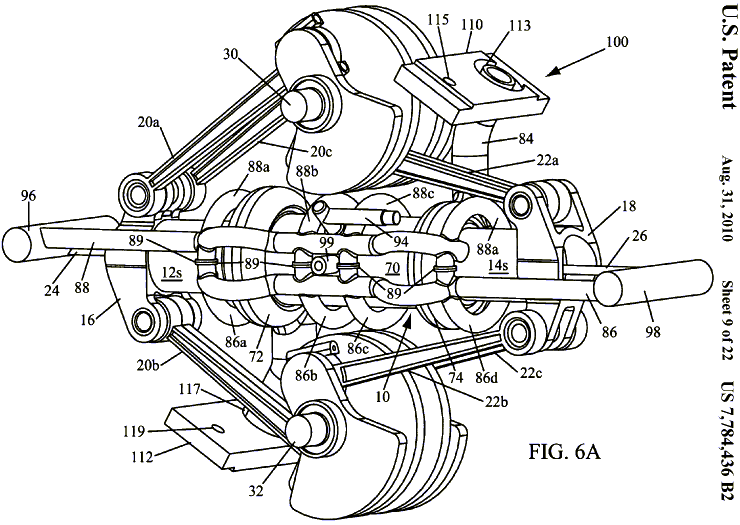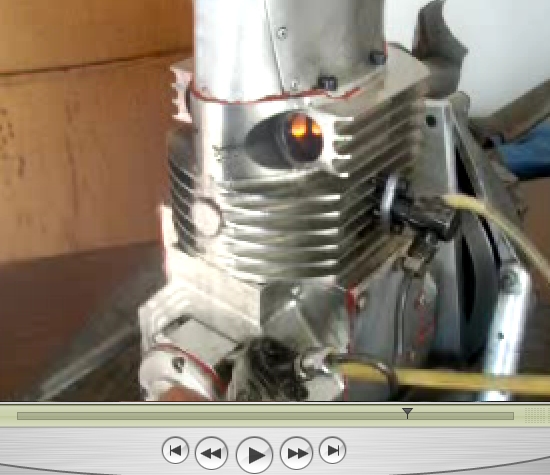Hello all.
In the #1498 post, the plot:

gives the lubricant consumption (the measurements were performed in the labs of Achates Power) of the dual-sided-crankshaft Opposed Piston engine of Achates:

Note:
It is not the specific lube consumption (gr of lubricant per kWh of energy provided); the lube consumption is provided as a percentage of the fuel consumption.
According these lab test results, the specific Opposed Piston engine (two crankshafts arranged at the sides of the cylinder, multiple connecting rods, piston skirt to cylinder liner: rid of thrust loads) has, “across the entire operating map”, a comparable to the state-of-the-art 4-stroke Diesels lube consumption.
In the page #101 of this discussion, it was mentioned the Diesel (or VW) Scandal according which some diesel cars were measured to emit several times more NOx in the real-world driving.
Regarding the NOx and the 2-stroke Diesel engines, here is a QUOTE from Achates Power:
The Achates Power Engine: Low NOx and Superior Efficiency

by Dr. Gerhard Regner
Vice President, Performance and Emissions, Achates Power, Inc.
Diesel engines have many virtues, including excellent fuel economy, great low-end torque and superior durability. They tend, though, to be more expensive than gasoline engines. One reason: for cars and trucks to meet global emissions standards, diesel engines need expensive aftertreatment equipment. The two most problematic diesel engine pollutants are NOx and particulate matter (PM). NOx—the general name for nitric oxide (NO) and nitrogen dioxide (NO2)—and PM have a somewhat inverse relationship. With low combustion temperatures, PM is higher and NOx is lower. With high combustion temperatures, NOx is higher and PM is lower.
Diesel engine manufacturers have several ways to reduce NOx emissions. Most on-highway cars and trucks in the U.S. and Europe use a selective catalyst reduction (SCR) system to convert NOx into nitrogen (N2) and water. In addition, many of these engines also employ exhaust gas recirculation (EGR) to impede the formation of NOx during combustion. Since oxygen is used up in the course of combustion, the gas remaining after combustion has low oxygen content. When this exhaust gas is put back into the combustion chamber, it reduces the temperature of combustion by diluting the oxygen concentration, impeding NOx formation.
The opposed-piston, two-stroke engine developed by Achates Power has inherent advantages in low NOx operation. There are several reasons for this. The first is that the Achates Power engine has good power density because it operates on a two-stroke cycle (each cylinder has a power stroke during each revolution of the engine). The power density can be used to either reduce the displacement of the engine (that is, generating the same power from a smaller engine) or to reduce the engine working pressure (usually measured as brake mean effective pressure, or BMEP)—or some combination of both. For example, when we design an engine to replace a medium-duty engine, like the Navistar MaxxForce 7 or the 6.7L Cummins ISB, we could create an engine with the same BMEP and half the displacement (3.35L) or we could develop an engine with the same displacement but half the BMEP (Note: When comparing BMEP between a two-stroke and four-stroke engine, one must cut the BMEP of the four-stroke engine in half because it’s the BMEP only during the compression and expansion stroke of the four-stroke engine that is compared). Based on considerations of size, cost and efficiency, the right balance is almost always somewhere in the middle of these two extremes (see below).

Engine developers calibrate their engines by varying EGR rates, injection timing, injection pressure and other factors to optimize fuel economy while meeting mandated emission levels—taking into account emissions reduction offered by aftertreatment equipment. Very often, calibration tradeoffs required to meet emissions result in worse fuel economy. For example, to reduce peak combustion temperatures, fuel injection timing can be delayed. This produces lower NOx and worse fuel efficiency. Because the Achates Power engine has lower BMEP than a comparable four-stroke engine, fewer calibration trade-offs are necessary to meet mandated NOx limits, enabling the Achates Power engine to be better optimized for high efficiency.
As a result, not only is the Achates Power engine more efficient, it has a superior BSFC/NOx trade-off curve, as illustrated below. BSFC stays low even at the tailpipe emissions limits of around 0.2-0.2 g/kWh.

A second feature of the Achates Power engine that is favorable for NOx control is the use of a supercharger in the air handling system. To control NOx, the Achates Power engine controller varies how much of the cylinder is scavenged during each cycle. Instead of exhausting the residual gases and then reinserting them back into the cylinder, the Achates Power engine can leave some of the residual there at the end of combustion. The engine controls how much exhaust gas is left in the cylinder by adjusting the supercharger recirculation valve to manage the pressure difference between the intake manifold and the exhaust manifold—the higher the differential, the more residual gases will be exhausted (and fresh air brought in). This technique of internal EGR (or iEGR) is very easily applicable to two-stroke engines—a four-stroke engine, by its very nature, exhausts 100% of the spent gas each cycle on a regular gas exchange cycle. By changing the valve timing of intake and/or exhaust, rebreathing of exhaust gas can be achieved. But, it takes work to expel exhaust gases from the cylinder, and it takes more work to recirculate the exhaust gas and put it back into the cylinder. The Achates Power iEGR implementation avoids this double pumping-loss penalty.

There are limits to how much iEGR can be used—at higher load conditions, using too much iEGR will cause the cylinder and piston temperatures to exceed safe limits. In these conditions, the Achates Power engine combines iEGR with external EGR (you guessed it, eEGR). The eEGR is cooled before it’s put back into the cylinder so it helps contain piston and cylinder temperatures and NOx formation.
But even when the Achates Power engine uses eEGR during high load conditions, it retains an efficiency advantage over conventional engines. Conventional engines use a variable-geometry turbocharger to pump the exhaust gas through a cooler and into the intake manifold. During high load conditions, when the conventional engine needs to pump a lot of exhaust gas, it closes the vanes of the variable geometry turbocharger. This increases the backpressure on the engine that drives the exhaust gas and also degrades turbocharger efficiency, reducing fuel economy. By contrast, the Achates Power engine uses the supercharger to pump the exhaust gas into the intake manifold, avoiding turbocharger efficiency losses. So, at both high eEGR and low eEGR conditions, the Achates Power engine has advantages. This leads to an interesting feature of the Achates Power engine—well positioned and broad islands of peak efficiency.
If you map out the speed (x-axis) and load (y-axis) of an engine, every engine is more efficient in some places and less efficient in others. Most engines are most efficient during high-load operation. One reason is that engine friction increases with load—there is more force acting on bearings, for example—but friction does not increase as quickly as the load does to the friction contribution per unit of load, which decreases as load increases. This is true for the Achates Power engine too. Another reason is that the work a four-stroke engine does to scavenge the cylinder—the work required for the exhaust stroke—is the same regardless of the engine’s load. In essence, it’s over-scavenging during light load conditions because it has no choice. By contrast, the Achates Power engine can reduce its scavenging work during light load conditions.
In general, a four-stroke engine incurs a higher scavenging and friction penalty—both per unit of load—at low loads and, therefore, is most efficient at high loads. The Achates Power engine, by contrast, has friction advantages at high loads and scavenging advantages at low loads so its peak efficiency is around mid-load points.

This is very convenient because most cars and trucks operate at low-to-mid load points much more frequently than they do at high load points. So, not only is the Achates Power engine more efficient than comparable four-stroke engines at the best efficiency points, it is even more efficient over any kind of representative duty cycle. In addition, because the efficiency islands are so broad, simpler transmission designs and less shifting are required.
There is yet another benefit, with regards to NOx, of the Achates Power engine: transient response. If a driver moves from a low-load to a high-load condition—by going up a hill, for example—the amount of exhaust gas that is recirculated must be instantly adjusted. But the turbochargers used in conventional engines have a lag—turbo lag. To reduce the impact of the turbo lag on drivability, EGR rates during transients are usually reduced so that NOx emissions are higher. This requires engine manufacturers to oversize their SCR systems. The Achates Power engine uses a supercharger to drive its exhaust gas. Since the supercharger is directly connected to the engine, it doesn’t incur any lag or require oversized aftertreatment systems. And, it has superior transient response.
END OF QUOTE
I would add that a 2-stroke (opposed piston of not) having not hot spots inside its combustion chamber (like the red-hot exhaust poppet valves of the 4-stroke engines) makes the formation of the NOx more difficult.
In the post #1197 of this thread, the 2-stroke Evinrude E-TEC G2 250 HO

appears substantially superior in fuel efficiency as compared to the 4-stroke Yamaha 250 SHO (there is a video in the Internet showing the superiority of the 2-stroke in the sea: starting with their fuel tanks full, the 2-stroke arrives at the destination island, while a the 4-stroke runs-out of fuel several dozens of miles before the island).
What the vice-president of Achates Power writes in the previous quote, fit to spark ignition 2-strokes, too: while the 4-stroke Yamaha runs over-stressed to make its power, the 2-stroke Evinrude E-TEC runs calmly and more efficiently and less polluting.
Put all the previous together and think of the PatOP engine:

Youtube video:
https://www.youtube.com/watch?v=2ByEgfTTq1I
The rid-of-thrust-load abutment of the piston skirt over the ported cylinder liner allows as low lube specific consumption as the Achates Power Opposed Piston with the two side crankshafts.
The 2-stroke cycle substantially reduces the problem of the NOx emissions of the Diesel (compression ignition) engines, just like the Achates Power claims for their 2-stroke engines.
The single-crankshaft structure of the PatOP eliminates the synchronizing gearing required in the Achates Power Opposed Piston engines (either those having a pair of side crankshafts, or their last models which replicate the Junkers Jumo with the two crankshafts at the ends of the cylinder).
This saves a lot of cost, of weight, of frictional loss, of noise, etc. And the engine becomes more reliable (not existing parts cannot fail).
Think a little more about it: with a single crankshaft the main bearings of the crankshaft run unloaded; in comparison, with two crankshafts, the main bearings are heavily loaded.
The PatOP with its pulling-rod architecture provides some 30% additional time for the preparation of the mixture and for the efficient combustion of it.
A PatOP compression-ignition engine can provide some 30% higher power output (running at the same BMEP) because the fuel droplets feel as being burned inside a conventional running at some 30% lower rpm.
The architecture of the PatOP enables a substantially smaller / shorter / lightweight engine: for a combined piston stroke of 128mm, the height of the first PatOP prototype (the built-in 850cc scavenging pump included) is only 500mm.
Thanks
Manolis Pattakos










